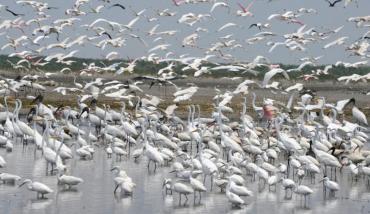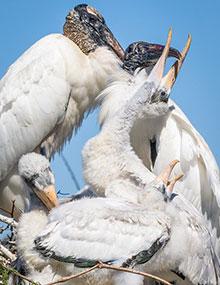
South Florida Water Management District reports record rainfall and its water management actions helped promote an above-average breeding season for wading birds.
This, after El Niño-related climatic conditions made the 2016 breeding season one of the worst in the last decade.
SFWMD's just-released 23rd annual South Florida Wading Bird Report shows several key "indicator species" of birds that are critical to gauging the health of the Everglades had an above average breeding season in 2017.
In particular, the wood stork, an indicator species, had a banner year, says the SFWMD in a written press statement. It nearly doubling the annual average number of nests over the past decade. The population of wood storks has been climbing for the past several years as SFWMD's work to restore the hydrology and water quality of the Everglades has progressed.
Wood storks were at the top of the list for population growth of the key wading bird species being studied last year. Staff counted more than 3,800 nests, roughly 1.8 times the average annual number of wood stork nests found over the past 10 years.
"Thanks partly to (SFWMD's) effort, the wood stork, once listed as a federally endangered species, was upgraded to a federally threatened species by the U.S. Fish and Wildlife Service in 2014," says the District.

"One of the primary goals of the Comprehensive Everglades Restoration Plan (CERP) and other ongoing restoration projects is to return the populations of wading birds in the Everglades to healthy numbers by improving the quality, quantity, timing and distribution of water in the system," said SFWMD Lead Environmental Scientist Mark Cook, who helped produce the annual wading bird report. "This report's findings show that with improved habitat and favorable weather conditions, wading birds can feed, breed and flourish."
SFWMD staff, in collaboration with staff from several partner agencies, counted 46,248 new wading bird nests between December 2016 and July 2017. That's more than a 73 percent increase in nesting activity from the 2016 breeding season when a drier-than-average summer of 2015 followed by unprecedented heavy rainfall during the typically dry season in early 2016 severely hampered nesting and led to one of the worst breeding seasons in the past decade.
The 2017 nest count was the second highest yearly count since 2009 and well above the five-year and 10-year averages for new wading bird nests found, says SFWMD.
The increased breeding activity of key indicator species of birds such as the great egret and white ibis can be attributed to that same heavy rainfall in early 2016 that resulted in poor nesting activity that year. However, those wet conditions in 2016 also increased the populations of prey such as fish that the wading birds feed upon, and the drier conditions in early 2017 concentrated the prey in smaller areas so the birds could feed upon them more easily.
Not all species studied had above average breeding years. The number of nests started by small herons continued a decline that has been observed for several years, the District admits. The exact reasons for the decline of nesting activity by these particular species is unknown but being studied further.
SFWMD also made regular observations of conditions and, subsequently, made critical water management decisions during this period, such as putting more water through the stormwater treatment areas into Water Conservation Area 2A to help promote habitat conducive for breeding.
"This is the essence of how water management based on sound science can help the environment thrive," said SFWMD Water Resources Division Director Terrie Bates. "Rainfall is out of our control and can fluctuate from year to year, leading to better or worse breeding activity. However, our efforts to restore habitat and water quality, as well as conduct careful operations of the water management system, allow us to optimize conditions for wading birds as much as possible."


